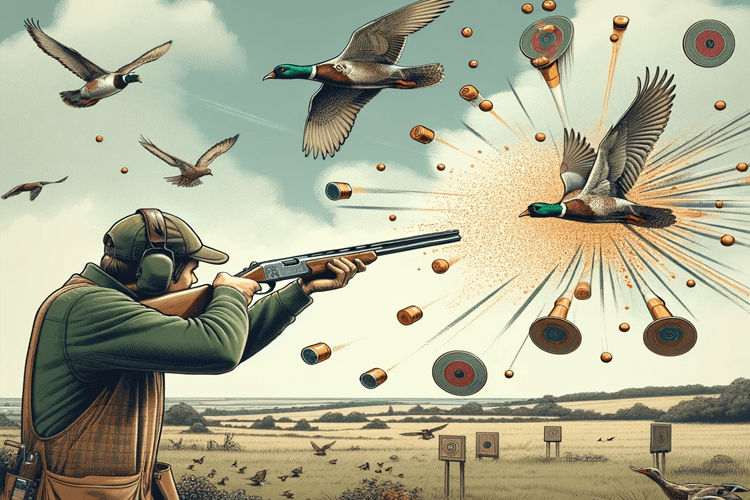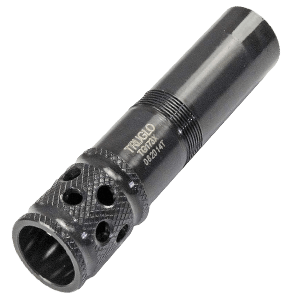Choke tubes are integral components in the world of shotgun hunting, playing a crucial role in determining shot accuracy and pattern. These seemingly small devices have a significant impact on a shotgun’s performance, choosing the right choke tube an essential aspect for any hunter or shooting enthusiast. A well-selected choke tube can dramatically improve the precision and effectiveness of your shots, ensuring a more successful and rewarding hunting experience.

In this article, we delve into the importance of choke tubes and explore their influence on shotgun hunting. Our step-by-step guide is designed to help both novices and seasoned shooters alike in choosing the ideal choke tube for their needs. Whether you’re aiming for tighter shot patterns at longer ranges or seeking a wider spread for close-range targets, understanding choke tubes is key to achieving your shooting objectives. We’ll cover everything from the basics of choke tube types and their functions to the nuances of selecting the right one for your specific hunting or shooting scenario.
Related Post:- Turkey Hunting Decoy
Related Post:- Best Turkey Hunting Books
Understanding the Basics of Choke Tubes
Choke tubes are cylindrical components that fit into the muzzle end of a shotgun, fundamentally influencing the spread of the shot as it exits the barrel. Their primary function is to shape the spread of the pellets, thus affecting both the range and accuracy of the shot. This customization ability makes choke tubes essential for hunters and sports shooters who need to adapt their shotguns to different situations and distances.
Different Types of Choke Tubes and Their Constrictions
1. Cylinder Choke

This type has no constriction and is ideal for close-range targets, up to 20 yards. It’s often chosen for home defense or fast-moving games at close distances. A cylinder choke typically places about 40% of the total shot in a 30-inch circle at 40 yards, offering a broad spread.
2. Improved Cylinder

With slightly more constriction than the cylinder choke, it is used for moderate distances, ranging from 20 to 30 yards. It’s versatile for small game or upland bird hunting, placing about 50% of the shot in a 30-inch circle at 40 yards.
3. Modified Choke

This is a middle-ground choice, suitable for a variety of hunting situations, including waterfowl and pheasant hunting at distances of around 30-40 yards. A modified choke typically achieves about 60% shot placement in a 30-inch circle at 40 yards.
4. Improved Modified

Tighter than a modified choke, it is effective for longer shots, typically between 35-45 yards. This choke is useful for distant flying birds or in situations where a tighter pattern is needed. It can place about 65% of the shot in a 30-inch circle at 40 yards.
5. Full Choke

The tightest standard constriction, best for long-range shooting, is particularly effective at 40 yards and beyond. It’s ideal for hunting waterfowl or turkey at longer distances, placing about 70% of the shot in a 30-inch circle at 40 yards.
The choice of a choke tube directly impacts the shot pattern and effective shooting range. A wider spread (like that from a cylinder choke) is beneficial for close targets, ensuring a higher hit probability, while tighter patterns (as produced by full chokes) increase precision at greater distances. Understanding these nuances is key to selecting the perfect choke tube for your specific shooting needs and conditions.
Factors to Consider When Choosing a Choke Tube
1 Hunting Environment
The hunting environment and the type of game significantly influence your choke tube choice. Different scenarios require different patterns for optimal performance:
- Waterfowl Hunting: Typically involves shooting at medium to long-range distances. A modified choke is generally suitable for average ranges, while long-range shots may require a full choke to keep the pattern tighter for distant birds.

- Turkey Hunting: Precision is key, as the target area of a turkey is small. A full or even extra-full choke is often recommended to maintain a tight pattern, maximizing the impact at 40 yards or more.

- Upland Bird Hunting: This includes hunting for pheasants, quail, and grouse, where shots are usually taken at closer ranges. An improved cylinder or modified choke is ideal, providing a wider spread to increase the chance of hitting fast-moving, close-range birds.

2 Shotgun and Ammunition
The bore diameter of your shotgun and the ammunition type play a vital role in choke tube selection:
- Bore Diameter: Shotguns with different bore sizes (like 12-gauge, 20-gauge, etc.) have unique performance characteristics with various chokes. It’s crucial to match the choke to your shotgun’s gauge and specific model.

- Ammunition Type: Steel shot behaves differently than lead shot and may require a less constricted choke for the same effect. Be mindful of the ammunition type – lead, steel, bismuth, tungsten – as each interacts differently with choke constriction. For example, steel shot, often used for waterfowl due to legal requirements, should not be used with extra-full chokes designed for lead shot.

3 Shot Pattern
Selecting a choke tube based on the desired shot pattern is essential:
- Tight Patterns: Desired for long-range shooting where precision is crucial, such as turkey hunting. Full or improved modified chokes are preferable in these cases to concentrate the shot and increase the likelihood of a successful hit.

- Open Patterns: Beneficial for close-range, fast-moving targets where a wider spread increases hit probability. Cylinder and improved cylinder chokes are ideal for such scenarios, typically encountered in upland bird hunting or when shooting clays.

Choosing the Right Choke Tube: A Step-by-Step Guide
Selecting the ideal choke tube can be streamlined into a systematic process. Follow these steps, and refer to the decision flowchart/checklist at the end for a quick reference.
- Identify Your Primary Shooting Activity: Determine whether you’ll be hunting (specify the game – waterfowl, turkey, upland birds, etc.) or participating in shooting sports like trap or skeet.
- Assess the Typical Shooting Range: Estimate the average distance at which you will be shooting. Close range (up to 30 yards), medium range (30-40 yards), or long range (40 yards and beyond).
- Understand Your Shotgun Specifications: Know your shotgun’s gauge and model. This information is crucial for selecting a choke tube that fits properly.
- Consider Your Ammunition: Identify the type of ammunition you will use (lead, steel, bismuth, etc.), as different materials pattern differently through choke tubes.
- Decide on the Desired Shot Pattern: Determine if you need a tight pattern for precision (long-range) or a wider spread for quicker target acquisition (close-range).
- Consult Choke Tube Constriction Guides: Use the guidelines provided earlier to match choke types with your needs. For instance, a full choke for long-range turkey hunting or an improved cylinder for close-range upland bird hunting.
- Environmental and Game Considerations: Factor in the environment where you will be hunting. Dense vegetation might require a more open pattern, while open fields might benefit from a tighter pattern.
- Test and Experiment: If possible, experiment with different chokes to see which pattern works best for your specific situation. Patterning your shotgun with the chosen choke and ammunition is highly recommended.
- Final Selection: Based on the above steps, make your final selection of a choke tube.
Choke Tube Selection Flowchart/Checklist
- Shooting Activity: Hunting (Specify Game) / Shooting Sport
- Shooting Range: Close (≤ 30 yards) / Medium (30-40 yards) / Long (≥ 40 yards)
- Shotgun Gauge and Model: ________ (e.g., 12-gauge, Mossberg 500)
- Ammunition Type: Lead / Steel / Bismuth / Tungsten
- Desired Shot Pattern: Wide / Moderate / Tight
- Recommended Choke:
- Close Range: Cylinder / Improved Cylinder
- Medium Range: Modified / Improved Modified
- Long Range: Full / Extra Full
- Environmental Factors: Dense Vegetation / Open Field
- Experimentation: Yes / No
- Final Choice: ________ (e.g., Full Choke)
This flowchart/checklist is a practical tool to guide you through the selection process, ensuring you consider all relevant factors in choosing the perfect choke tube for your shotgun.
Maintenance and Care of Choke Tubes
Proper maintenance of choke tubes is crucial for ensuring their longevity and optimal performance. Neglect can lead to issues like corrosion or difficulty in removing the choke from the shotgun. Here are key tips on how to clean and store choke tubes:
- Regular Cleaning: After each use, clean your choke tubes to remove any residue, dirt, or moisture. This is especially important if you use corrosive ammunition or hunt in wet conditions.
- Use Proper Cleaning Solutions: Use a solvent designed for firearms to clean the choke tubes. Avoid harsh chemicals that can damage the choke tube’s finish or the threading.
- Thorough Drying: After cleaning, ensure the choke tube is completely dry. Any moisture left can lead to rust or corrosion.
- Lubrication: Apply a thin layer of gun oil or a specific choke tube lubricant to the threads. This helps prevent rust and makes it easier to install and remove the choke.
- Check for Wear: Regularly inspect your choke tubes for signs of wear, damage, or corrosion. If a choke tube is damaged, it should be replaced to maintain the safety and accuracy of your shotgun.
- Proper Storage: Store choke tubes in a dry, cool place. Using a choke tube case or holder can protect them from dust and damage.
- Avoid over-tightening: When installing a choke tube, ensure it’s snug but avoid over-tightening, as this can damage the threads.
- Use the Right Tools: If your choke requires a wrench for installation or removal, use the correct tool to avoid damaging the choke or shotgun.
What Is a Shotshell?
Understanding the components and mechanism of a shotshell is crucial for shotgun users, especially when considering the compatibility and performance implications with different choke tubes. Here’s an overview of the shotshell:

- Primer: This is the ignition component of the shotshell. Located at the base of the shell, the primer detonates when struck by the shotgun’s firing pin, initiating the firing process.
- Gunpowder (Propellant): Following the primer in the base of the shell is the gunpowder. When the primer ignites, it sets off the gunpowder, which burns rapidly, creating gases that increase pressure inside the shell.
- Wad: Above the gunpowder is the wad. This small cup-like component serves several purposes: it seals the gases produced by the burning gunpowder, ensuring efficient propulsion of the shot; it protects the shot from deforming by keeping it separate from the hot gases; and upon firing, it helps maintain the integrity of the shot pattern as it travels down the barrel.
- Shot: At the top of the shell, above the wad, is the shot – a collection of small, round pellets. The size and material of the shot can vary depending on the intended use (e.g., bird hunting, target shooting). When the shotshell is fired, the shot spreads out in a pattern that is influenced by the type of choke tube used in the shotgun.
- Casing and Crimp: The entire assembly of primer, gunpowder, wad, and shot is contained within a casing, typically made of plastic with a metal base. The open end of the shell is sealed with a crimp, which prevents the shot from falling out and ensures that the pressure needed to propel the shot is built up effectively.
Popular Choke Tube Brands
Several manufacturers are renowned for producing high-quality choke tubes, each offering unique features and models known for their performance and durability. Here are some of the most reputable choke tube brands:
1. Carlson’s XR Turkey Hunting Choke Tubes
Best Overall

⚙ Product Specifications
- Gauge: 12 Gauge
- Bore: 0.660 inch
- Length: 3.5 inches
- Material: 304 high-stress stainless steel
- Warranty: Lifetime warranty
2. TRUGLO Gobble-Stopper Choke Tube
Best Budget

⚙ Product Specifications
- Gauge: 12-20 Gauge
- Bore: Cylinder
- Length: 2.25 inches
- Material: 304 high-stress stainless steel
- Warranty: Lifetime warranty
3. Browning Midas Turkey Choke Tube
Versatile Use

⚙ Product Specifications
- Gauge: 12 Gauge
- Bore: 0.729 inch
- Length: 2.75 inches
- Material: Stainless steel
- Warranty: Lifetime warranty
Conclusion
The right choke tube can make a significant difference in your hunting success, offering improved accuracy and effectiveness. It’s not just about the gear but how well it aligns with your specific hunting scenarios and requirements. By making an informed decision, considering all these aspects, you can enhance your shooting precision and enjoy a more rewarding hunting or shooting experience.
Additional Resources
For those interested in delving deeper into the world of choke tubes, here are some valuable resources for further reading and exploration:
Books and Manuals:
- “The Shooter’s Bible Guide to Shotgun Sports” by Alex Brant – A comprehensive guide covering various aspects of shotgun sports, including detailed sections on choke tubes.
- Shotgun manufacturers’ manuals often have specific sections on choke tubes, offering insights into the best practices for their products.
Online Forums and Communities:
- Websites like ShotgunWorld and TheHighRoad have active communities where experienced shooters share advice and experiences.
- Reddit communities such as r/Shotguns offer a platform to ask questions and discuss topics related to shotguns and choke tubes.
YouTube Channels:
- Channels dedicated to shooting sports often have tutorials and reviews on choke tubes. Look for channels with a focus on shotgun hunting and clay sports.
Hunting Magazines and Websites:
- Publications like “Field & Stream” and “Outdoor Life” often feature articles on shotguns and accessories, including choke tubes.
- Online hunting forums and websites also provide useful articles and buyer’s guides.
Local Shooting Clubs and Ranges:
- Joining a local shooting club or visiting a shooting range can be a great way to get hands-on advice and try out different choke tubes.
These resources can offer a wealth of information, from the basics to advanced tips, helping you make well-informed decisions and improving your overall shotgun shooting experience.
Leave a Reply